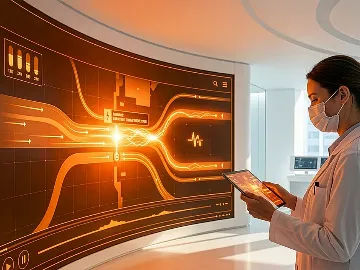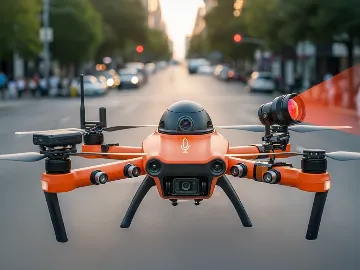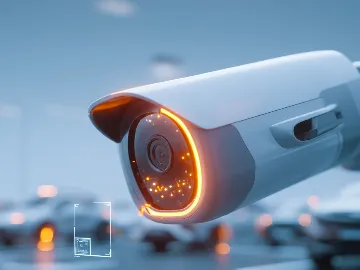Whether you are a healthcare software development company or a healthcare provider, there are plenty of ways your business can benefit from adopting computer vision (CV).
For example, CV-based solutions help doctors run more effective check-ups, detect potential pathologies early on, and prevent complications. They can also improve hospital administration and medical facility management while decreasing labor costs. And if you’re a medical tech company, you can offer computer vision for healthcare institutions and secure your prosperity in the fast-growing CV market.
Below, we’ll discuss how this technology works, how to use it in real-life medical settings, and how N-iX’s team can help you integrate computer vision effectively. But first, let’s explore why you should consider adopting computer vision in healthcare.
Benefits of adopting computer vision in healthcare
Regardless of where your business stands in the healthcare supply chain, you can increase the value of your business offer by integrating CV solutions.
Here are a few benefits of computer vision application in healthcare businesses that develop medical products and tech tools.

- Diversification of services. Adding trending technologies to your service lists helps your business cater to more healthcare needs. It will result in landing more clients, boosting upselling and cross-selling, and increasing market share.
- Establishing new partnerships and collaborations. Global healthcare systems and companies are ready to invest in solutions to expand their capabilities and make their services more attractive to customers. With computer vision in your offer, you can become an attractive partner for hospitals, clinics, and research institutions.
- Future-proofing your business. With ever-increasing medical data to interpret, global healthcare worker shortage, and lack of affordable on-premise and remote medical services, healthcare providers are looking for ways to improve patient care and streamline medical processes. By developing CV-based solutions, you can provide sought-after tools and gain a competitive edge in the market.
If you’re a healthcare provider, integrating computer vision into your practice can help you obtain the following advantages.

- Early disease detection. With a quality CV, you can improve patient outcomes by timely detecting early signs of diseases, such as cancer, diabetes, or vision disorders. Treating them during the early stages will save your patient money and life and improve your reputation on the market.
- Faster and more precise diagnostics. Computer vision algorithms expedite medical image analysis. The best part? According to research, the algorithms are 6.5% more accurate at melanoma diagnostics than humans.
- Expanded remote patient monitoring services. Сomputer vision in healthcare allows providers to monitor patients' conditions remotely. It will reduce the need for in-person visits and in-patient care costs. Plus, you can offer your services to more patients from nearby regions, increasing your revenue.
- Enhanced surgical services. Paired with augmented reality (AR) and virtual reality (VR) technologies, computer vision can assist surgeons during complex surgeries and improve patient safety.
- Improved hospital and patient administration. From reducing manual data entry to streamlining patient flow and more effective resource management, computer vision is a go-to solution to increase value inside and outside the cabinets.
- More patient-centered experience. An astonishing 80% of healthcare providers plan to move towards patient-centricity and prioritize improving patient experience. With computer vision in your healthcare practice, your doctors will do less manual work, have more time to spend with patients, and provide them with quality services that will improve the quality of their lives.
Adopting computer vision in healthcare solution development or practice ensures the longevity of your medical or tech business. More importantly, its implementation also improves the outcomes for the end customer–the patient. With healthcare systems becoming more patient-centered and more healthcare providers prioritizing patient experience, you should analyze where to add more value to win more business clients or patients.
Since CV technologies can significantly improve the quality of services you provide, let’s briefly discuss how they work in the healthcare industry.
How CV works in the healthcare industry
As a part of artificial intelligence and machine learning science, computer vision enables connected sensors to capture visual information and use it for further analysis, decision-making, classification, and segmentation.
Here are the key components and technologies necessary for successful computer vision implementation.
- Hardware: scanning and imaging machines, such as X-ray, MRI, CT, ultrasound, and endoscopes.
- Software: classification, detection, and image segmentation algorithms; convolutional neural networks (CNN) and deep learning algorithms; image post-processing and 3D model designing tools; deep learning frameworks.
Together, they‘re used to perform the following tasks:
- Medical imaging: creating a visual representation of the organs or tissues with X-rays, ultrasound, MRI, or CT machines.
- Object recognition: identifying abnormalities (e.g., recognizing malignant moles).
- Semantic segmentation: differentiating, classifying, and categorizing data (e.g., recognizing malignant moles from benign ones).
- Instance segmentation: identifying and separating individual objects within the image and assigning a unique label to each object (e.g., identifying the cancer type and stage based on cell image and location).
- Object detection: detecting the precise location of the objects (e.g., detecting the location of the implanted devices in organs or tissues).
- Object identification: processing visual data to identify the individual quality of an object (e.g., identifying the fingerprints of a particular patient).
All these tasks are essential for medical image interpretation, lab test analysis, monitoring tools, and more. Let’s review computer vision in healthcare applications with real-life examples.
Read more: How to find a reliable computer vision development company?
Computer vision application in healthcare: Top 10 use cases
CV can be used for facility administration and clinical purposes. Let's review the most common computer vision use cases that benefit hospital employees, healthcare businesses, and patients.
Facility administration use cases
Facility management directly influences the quality of care, and it can either cause more chaos or help the administration run the facility with ease. Here are a few CV solutions that make inventory, asset, and environment management a breeze.
Asset tracking
With the help of sensors, tags, and UDI or RFID scanning, asset tracking solutions identify the precise location of inventory items in real time. Сomputer vision in healthcare allows the hospital workers to cut time managing the stock, and the hospitals to avoid double-spending on the items they already have but deem lost.
Example: Zebra's RFID reader is a CV tool that improves the management of critical medical devices or hospital equipment that contributes to positive patient outcomes or have a significant monetary value [1].
Inventory management
Inventory management systems prevent stock-outs or overstocking, eliminate manual counting, identify and reserve items immediately, and keep inventory records in real-time. As a result, the hospital departments, including ER, critical care, and intensive therapy units, can manage their resources more efficiently and ensure they have everything needed to provide exceptional patient care.
Example: Solutions like Smart Cabinets by LogiTag help manage high-value medicines and devices by tracking product usage, status, procedure, and distribution cycle data. It prevents situations where taking too much time to find a catheter or other device can cost critically ill patient life [2].
Environment monitoring
Environment monitoring tools that have computer vision components allow hospital workers to keep track and set up proper environmental conditions for chosen areas. When integrated into the hospital ecosystem, they become a part of a centralized solution that enables 360-degree facility overview. It helps analyze the patient flow, quickly assess situations in units that require special attention (like intensive care), and accommodate resources at every unit.
Example: FIWARE platform, a Smart Hospital solution used by Dr. Peset Hospital of Valencia, is another application of computer vision in healthcare that helps prevent overcrowding and keep the facility safe. FIWARE includes visualization tools and an easy-to-navigate dashboard to simplify the monitoring process and reduce manual work [3].
These CV-based healthcare administration solutions are commonly used within hospital facilities. Let's review those that help doctors and clinical researchers in their practice.
Clinical use cases
Computer vision in hospitals is commonly used to aid doctors and researchers with patient treatment and diagnostics. Some of them, however, can also be used by patients at home. Here are the top seven clinical use cases of healthcare computer vision.
Blood loss monitoring
Blood loss monitoring is one of the computer vision use cases in healthcare that has already proven clinical results. These tools help prevent hemorrhage, which, in turn, reduces the need for blood transfusion, shortens the length of patient stay, and cuts costs associated with it.
Example: Triton, a blood loss monitoring system, identifies early the signs of post-surgical hemorrhage by analyzing images of surgical sponges and canisters taken with the connected iPad in the operating room. It decreases a chance of a patient dying from inaccurate visual estimation of blood loss. [4].
Pathology diagnostics
Computer vision for medical devices can identify pathologies with image analysis. With them, the researchers and clinicians have the speed and accuracy of image processing to conduct effective examinations and trials.
Example: AISight1, a cloud-native workflow solution, integrates into the digital laboratory information systems and connects to image scanners on-site to process visual data. Its algorithms assist with biomarker and tumor cellularity quantification, disease severity detection, and molecular prediction [5].
Remote patient monitoring
Telemedicine also benefits from adoption of computer vision solutions in healthcare as this AI technology expands the list of remote medical services you can provide. Remote patient monitoring is one of them. CV solutions can reduce care costs, mitigate personnel shortage consequences, monitor more patients simultaneously, and improve bedridden patient care.
Example: AvaSure Telesitter, a virtual safety attendant system, helps hospitals and families to provide nursing care 24/7. This CV solution makes supervision of patients in need at home or in a medical setting affordable [6].
Robot-assisted surgery
Computer vision can also help surgeons to perform complex procedures with better precision and less invasion. Using these systems shortens the patient's recovery time, prevents accidents, reduces blood loss, and improves patient outcomes.
Example: The da Vinci surgical systems allow doctors to reach tissues deeper and perform surgeries with smaller incisions. This low-invasive technique is possible thanks to remote controlling of surgical tools and highly-magnified 3D high-definition imaging of the surgical area [7].
Remote urinal testing
Computer vision technology democratizes access to healthcare and helps patients detect early signs of health-threatening conditions and start intervention immediately. CV-based solutions can be used to visually measure the ratio of specific urine components without booking a doctor's appointment.
Example: Minuteful Kidney, a take-at-home urinal test, helps measure albumin to creatinine ratio (ACR) to assess the risk of cardiovascular and kidney disease. This solution is available for delivery to be used by at-risk patients (elderly, prone to certain conditions) at home [8].
Remote wound management
Сomputer vision in healthcare can also make wound management easier and enable it remotely. CV-based tools help patients assess the wound condition in real-time as a part of their wound monitoring routine or right after accidents by processing the images obtained from mobile phones.
Example: Minuteful for Wound is another CV-based tool from the same company. The patient scans the wound with the 3D app scanner that captures high-resolution images for further analysis. The algorithm then detects the wound cause, which helps make an evidence-based decision and create further treatment plans [9].
Diabetic retinopathy diagnostics
CV also plays a crucial role in retina diagnosis. Timely and quality retinal image screening helps prevent vision loss in adults who have diabetes and in previously undiagnosed patients.
Example: The IDx-DR system detects and automatically diagnoses diabetic retinopathy by analyzing retinal images. It's used in clinical environments during routine checks with ophthalmologists to spot early signs of the disease [10].
This list represents only a handful of computer vision use cases in healthcare. Most of these out-of-the-box CV solutions might often lack scalability or customization your company needs. If you overlook specific details about your organization, legacy system peculiarities, and further business strategy when adopting such a solution, it can only lead to draining your budget.
A custom solution is a better option in this case as the engineers will design and develop a computer vision healthcare tool based on business-specific requirements for the IT infrastructure you have or plan to create. If your business needs a robust computer vision tool or you want to assess the feasibility of CV adoption to remain competitive, N-iX is ready to become your development partner.
Here are a few cases of collaboration with Fortune 500 companies where we integrated computer vision and future-proofed their businesses.
N-iX expertise in computer vision application
The performance of CV-based software depends heavily on the quality of machine learning algorithms and data processing. With a strong data unit of over 200 data engineers with proven expertise in Data Science AI, and ML, and specialists in Cloud and IoT, N-iX has it all to successfully implement computer vision in your healthcare practice. Here are a few projects our data team worked on.
Our client, a Fortune-100 logistics company, needed to innovate its inventory management and set a solid foundation for further scaling. After business analysis and careful planning, we included a computer vision component. It helped the company improve its warehouse process automation and manage its hubs more efficiently.
We also have expertise in developing medical solutions for WEINMANN Emergency, a leading manufacturer of emergency equipment in Germany. Our dedicated team helped improve its MEDUCORE Standard² solution and release it faster while complying with stringent healthcare regulations and policies.
During our long-term collaboration with various-sized companies, we've established the best practices and created industry-tailored guidelines that would facilitate the adoption of technologies. If you're considering adding a computer vision component, here are a few things to start this journey successfully.
Five tips for successful adoption of computer vision in healthcare from N-iX developers
Whether you already have experience with healthcare computer vision solutions or assess whether they'll be a perfect fit for you now, these tips will help you avoid costly mistakes and set your project up for success.
1. Assess your current facility infrastructure and IT systems
The time and cost of healthcare computer vision adoption depend heavily on your practice's existing infrastructure. We recommend thoroughly analyzing your IT systems before planning any solution. For instance, computer vision consulting services would help your in-house or outsourced tech teams estimate the scope of work, choose the best technology for the available resources, and stay within your budget during development.
2. Comply with legal requirements regarding data collection and processing
Healthcare is one of the most regulated industries, so the businesses operating in this sector should comply with various regulations, especially those governing data processing. Make sure you and your development team are familiar with the policies and have everything needed to comply with them.

3. Develop a CV adoption plan
Effective preparation is key to successful adoption. That's why we at N-iX create detailed plans and schedules to streamline the development processes and be more flexible in managing changes.
4. Measure the impact of CV adoption on your business
Measuring the impact of new technology on business is necessary for a few reasons.
First, it will help you estimate the ROI. Second, it will show how this adoption affected business in general. Third, it will help you estimate whether you need to continue investing.
Within computer vision outsourcing, we recommend you choose specific KPIs to assess the as-is state and measure the impact of CV after adoption. This way, you'll have more data to make informed strategic decisions.
5. Partner with an experienced tech vendor
The tips above are common for every business considering CV adoption. However, your specific case may need a tailored approach. This is why you should opt for a tech partner like N-iX with expertise in your target field. Our skilled team will provide you with a high-performance, compliant, and scalable computer vision solution to your unique business challenges.
Final thoughts
Computer vision in healthcare is an advanced technology that helps various stakeholders to provide or access better medical services. It helps the doctors deliver quality medical services on-site and remotely. It powers medical researchers with tools that ensure clinical trials and examination accuracy. The best part? It improves patient outcomes within and outside the hospitals.
If you plan to adopt healthcare computer vision, contact the N-iX team, and let's discuss how this technology will make a difference in your practice!
References:
- https://www.zebra.com/ap/en/solutions/industry/healthcare/use-case/hospital-asset-tracking.html
- https://globalmedics.co.nz/media/GM_-_Smartcabinet_Brochure.pdf
- https://www.fiware.org/2023/10/13/dr-peset-valencia-a-smart-and-connected-digital-hospital/
- https://www.safeor.com/triton
- https://www.pathai.com/ap-lab-solutions/
- https://avasure.com/telesitter/
- https://www.intuitive.com/en-us/patients/da-vinci-robotic-surgery/about-the-systems
- https://healthy.io/services/kidney/
- https://healthy.io/services/wound/
- https://www.healthvisors.com/en/idx-dr/
- When the walls come tumbling down: the hospital of the future by PwC
- How to Navigate Structured and Unstructured Data as a Healthcare Organization by HealthTech
- What is the cure for the global healthcare worker shortage? by Financial Times
- Man against machine: diagnostic performance of a deep learning convolutional neural network for dermoscopic melanoma recognition in comparison to 58 dermatologists by Haenssle et al.
- 2021 Healthcare CEO Future Pulse by KPMG




